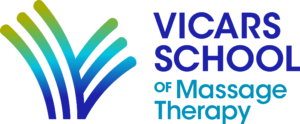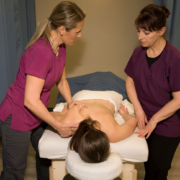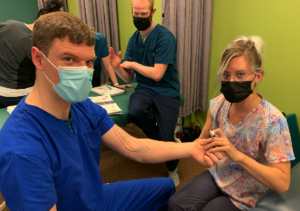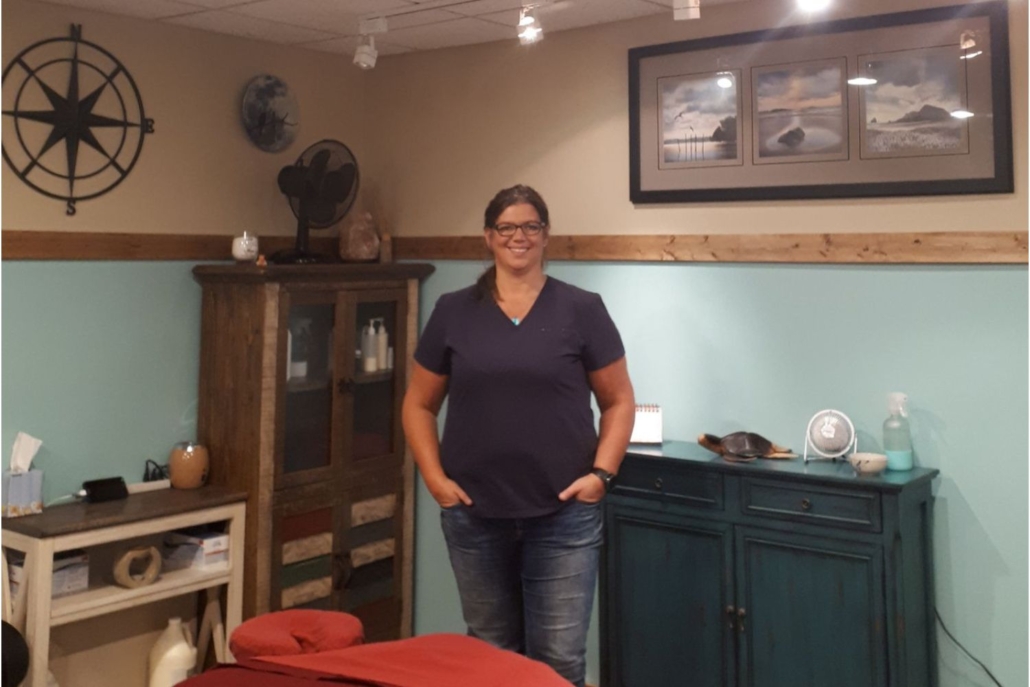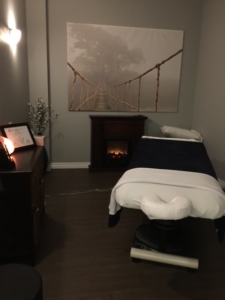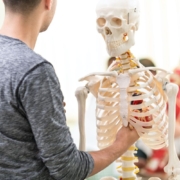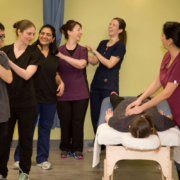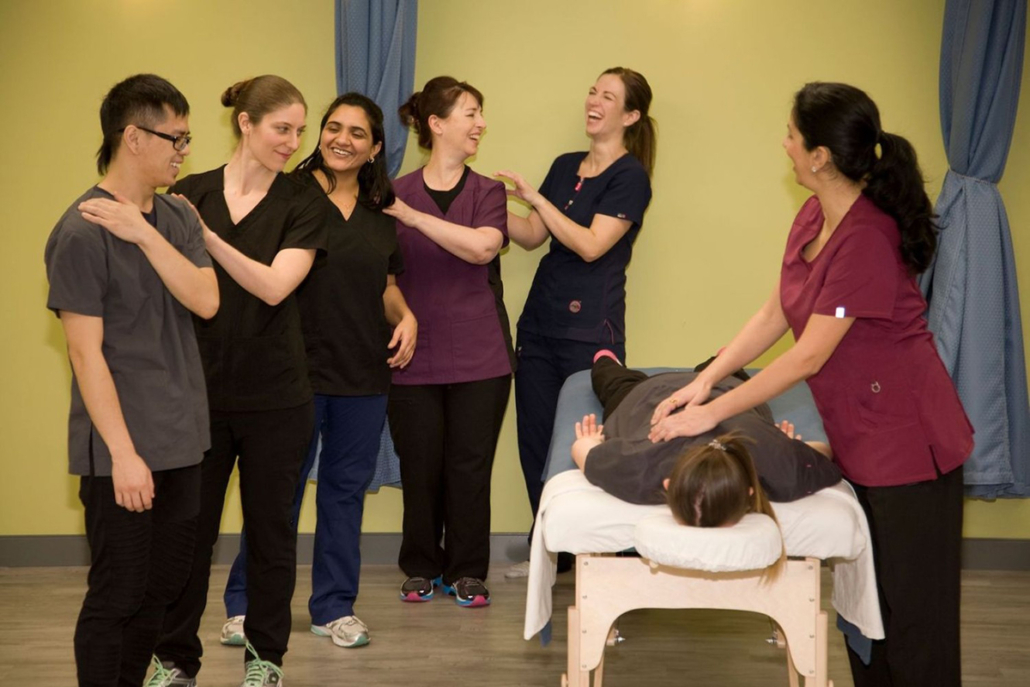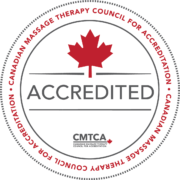This is the first in a series about pediatric massage: massage therapy for children ranging from infants to adolescents. In this first post, you’ll learn about massage therapy for infants, including its potential benefits for both parents and child and the science that assesses those benefits.
Pediatric massage has been practised around the world for millennia and is foundational to child-rearing in many cultures.
In Europe, Canada, and elsewhere in North America, pediatric massage is rapidly gaining popularity. Because of the vulnerability of children (age, physical sensitivity, immature language skills), professionals and parents must ensure massage therapy will help, not harm. Massage therapy research provides non-biased evidence that can be used by parents, massage therapists, and within healthcare facilities.
Of course, like any research into any complementary and alternative medicine, massage research is a challenge: funding is scarce, and it is hard to get definitive results in a study where double-blind studies are impossible.
One of the leading researchers in the field of touch therapy is psychologist Tiffany Field. Dr. Field has led ground-breaking clinical research over the past four decades that gives a greater understanding of the effects of pediatric massage. She is an award-winning professor at the University of Miami Miller School of Medicine where she founded the Touch Research Institute. One of her goals to provide a scientific rationale and understanding of pediatric massage therapy to inform practice and policy.
“Touch is critical for children’s growth, development, and health,” writes Dr. Tiffany Field of the University of Miami’s Touch Research Institute.
In her graduate training, Dr. Field worked on a neonatal intensive care unit looking for ways to improve weight gain in premature infants (preemies), so that they could be released from hospital sooner. The preemies were on feeding tubes and Field found that when they were given nipples to suck on, they gained weight. She proposed that if mouth stimulation could benefit the babies, then whole body stimulation—massage—would also benefit.
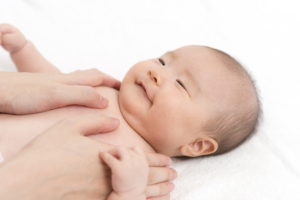
Infant massage therapy helps parents and baby bond, and offers many physical benefits to the baby
She was proven right: massaged preemies thrived when regular massage was added to their care. They showed significant weight gain and were able to go home to their families several days earlier than non-massaged preemies. When her own daughter was born prematurely, Dr. Field used her in her massage therapy research. Since then, investigating the potential of touch to improve health became the foundation for Dr. Field’s career.
In 1986, she and her research colleagues developed a moderate pressure massage protocol for their research studies on hospitalized preemies that has been used globally. Dr. Field’s pioneering work in hundreds of studies resulted in her authorship of dozens of books and hundreds of peer-reviewed scientific papers.
A scientist looks at infant massage therapy
One of Dr. Field’s seminal papers was a review in 2019 of all academic pediatric massage therapy studies published between 2008 and 2018 that investigated the effects of massage on various pediatric health conditions. In addition to faster weight gain and shorter hospital stays, premature infant massage therapy resulted in reduction of infection, better pain tolerance and immune function, better developmental scores for babies born of mothers with HIV or cocaine addiction, and reduction of parental stress.
Getting to the “how it works”
Dr. Field’s review also considered the bodily mechanism—how it works—that are thought to lead to the physiological responses to massage therapy. For example, the mechanisms behind premature babies’ weight gain after massage therapy are thought to be increased gastric motility (movement of food through the gut) and stimulation of the vagus nerve, which regulates bodily functions such as heart rate, breathing, and stress hormones.
Massage also leads to increases in levels of insulin, which helps regulate blood sugar, and increases in natural killer cell activity, an important defence against infection in an infant’s immature immune system. But Dr. Field says that validating how and which bodily mechanisms are activated by massage requires additional research.
Massage therapy effects on full-term newborns were also included in Dr. Field’s review, with reported results similar to those found when the small subjects had been born prematurely. In both groups, results included decreases in bilirubin (jaundice) levels, sleep disturbances, irritability, colic, crying, and facilitation of infant development and reduction of stress in parents.
Parental stress and anxiety interfere with the attachment that is vital between parents and their infants. Maternal infant bonding increases self-confidence in mothers and positive mental health in later life for infants. A 2019 UK literature review by community practitioners, spanning 36 years of publications, showed that in some of the studies, massage therapy performed by mothers on their babies showed improved maternal infant bonding, with higher levels of improvement for mothers who experienced moderate mental health issues.
Another systematic review of five years of massage therapy studies, representing more than 1400 participating newborns (under the age of one year), was undertaken by Swedish researchers and published in Maternal, New-Born and Child Health in 2022. While the review focused on health benefits to infants attributed to massage, it highlighted the effect of parent-given massage in significantly reducing post-partum depression experienced by both parents.
Other research, including a study published in 2011 in Journal of Perinatal Education, found that during the early postpartum period, infant massage conducted by fathers “significantly decreased paternal stress” and increased bonding with their babies. As with most massage therapy research, the caveats apply: more research is needed to fully understand and verify the mechanisms behind massage therapy’s effects.
Growing popularity of pediatric massage therapy
Evidence produced by researchers like Dr. Field is helping to establish the legitimacy of pediatric massage therapy in clinical settings such as neonatal intensive care wards. Outside hospital settings, the popularity of pediatric massage therapy is growing because of its observable emotional, social, and health benefits for the children, but also for the caregivers or parents who give the therapy.
Pediatric massage therapy training
Graduates of Vicars School of Massage Therapy receive an introduction to pediatric massage as part of the curriculum. All Vicars graduates can conduct safe, nurturing massages on people of any age, including infants and children, but some go on to enroll in continuing education to obtain a post-grad professional certificate in infant massage.
For full-term babies or premature infants who are home from hospital, infant massage is generally performed at home as an enjoyable and health-promoting part of baby’s care.
RMTs with infant-massage training often conduct workshops or give individual training to new parents to help them learn an effective and safe massage routine. Many communities offer parent-child massage workshops and courses as well.
If you cannot find a class near you, there are excellent online resources to guide you in delivering a simple, short and playful massage to your child. These videos are a great place to start:
Still to come in our blog series: Research on the effects of massage on conditions in older children, the benefits of massage in strengthening the parent-child relationship beyond infancy, and a conversation with a Vicars grad about why she loves providing infant massage training in her practice.
Kathleen Thurber is a health and science writer. She lives in Edmonton.
